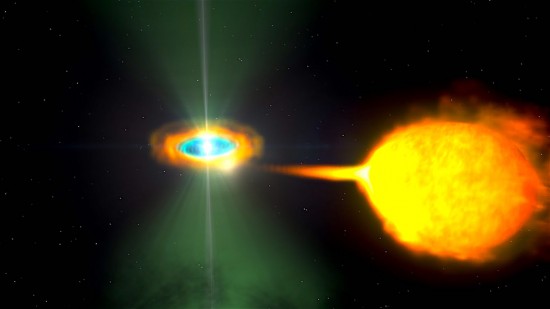Oct 7, 2015
Pulsars rotating faster than a dentist’s drill?
Pulsars are described as “lighthouses” with rotating beams of energy concentrated at specific points. Plasma physicists Anthony Peratt and Kevin Healy noted that:
“Because of the stability of the pulse period, Thomas Gold concluded that pulsars must be highly magnetized, rapidly rotating neutron stars. This model of a pulsar’s emission qualitatively describes it as high energy plasma beams emitted from the poles of a spinning neutron star and accelerating along the star’s dipole magnetic field, emitting curvature radiation as [it] pulses towards the observer…most new observations have been able to be described in terms of the standard, search-light model.”
Rotational mechanisms are the only conventional method for neutron star pulsations, so it is the spin of a pulsar that brings its beam in line with telescopes on Earth. However, the rotation rates of some pulsars are clocked at millisecond speeds—there are pulsars with frequencies as high as 716 hertz. Nothing known to science can withstand the forces involved with those spin rates, so “neutron stars” were mathematically created. Only something so dense was thought able to withstand the rotational velocity. It must be stressed that evidence for their existence is indirect and no neutron star has ever been observed.
According to a recent publication, the rapid blink rate of millisecond pulsars is ascribed to companion stars that are “cannibalized” by intense gravity from the neutron star. As more stellar material is accreted onto its surface, the pulsar is prevented from cooling off and slowing down as it ages.
Past Picture of the Day articles take issue with the entire concept of neutron stars. The Electric Star theory sees them as no more “real” than the Invisible Pink Unicorn. Deficits in gravity-only cosmology made the neutron star hypothesis necessary because gravity is all that is available in the consensus lexicon.
In an Electric Universe, it is a star’s capacitive, resistive, and inductive electrical environment that generates oscillations. Compacted matter and extreme rotation are not necessary; electricity traveling through circuits provides a coherent explanation that is consistent with commonly accepted electromagnetic theories.
It is intense magnetic fields pulsing in fractions of a second that astronomers observe. It is a well-known fact that magnetic fields are induced by the movement of electric charge. Therefore, there must be an intense electric field generating the magnetic fields in a pulsar. It is also indisputable that the feeder current must be part of a circuit, since persistent electric current must move through a completed circuit.
Pulsars are resonant effects in electric circuits. “Double layer detonation” is responsible for their energetic outbursts. Pulsars do not shine in optical light alone, sometimes they radiate in X-ray and gamma ray wavelengths. Their outbursts begin with a sudden peak of energy, then gradually decline, like a lightning bolt, another example of double layer detonation.
As electric current moves through dusty plasma, it concentrates forces because of the Biot-Savart effect, drawing itself together and forming helical zones of immense compression known as “z-pinches” or “Bennett pinches.” Depending on how much electricity is flowing through the circuit, a star’s magnetic field can become extremely powerful. It seems more likely that pulsars are an immense concentration of electricity being focused by some kind of “plasma gun” effect.
Stephen Smith
Hat tip to William Thompson













